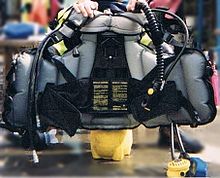ABLJ

Jacket type BC on diving cylinder
|
|
| Acronym | BC or BCD |
|---|---|
| Other names | Buoyancy control device |
| Uses | To adjust and control the overall buoyancy of the diver |
| Related items | Backplate and wing |
A buoyancy compensator, also called a buoyancy control device, BC, BCD, stabilizer, stabilisor, stab jacket, wing or ABLJ depending on design, is a piece of diving equipment containing an inflatable bladder which is worn by divers to establish neutral buoyancy underwater and positive buoyancy on the surface, when needed. The buoyancy is controlled by adjusting the volume of air in the bladder. The bladder is filled with gas from the diver's primary breathing gas cylinder via a low-pressure hose from the regulator first stage, directly from a small cylinder dedicated to this purpose, or from the diver's mouth through the oral inflation valve.
They can be broadly classified as having the buoyancy primarily in front, surrounding the torso and behind the diver. This affects the ergonomics and to a lesser degree, the safety of the unit. They can also be broadly classified as having the buoyancy bladder as an integral part of the construction, or as a replaceable component supported inside the structural body.
The buoyancy compensator is one of the items of diving equipment most requiring skill and attention during operation, as control is entirely manual, and adjustment is required throughout the dive as weight reduces due to gas consumption, and buoyancy of the diving suit varies with depth. Fine buyancy adjustment can be done by breath control, reducing the amount of actual BCD volume adjustment needed, and a skilled diver will develop the skill to adjust volume to maintain neutral buoyancy while remaining aware of the surroundings and performing other tasks. The buoyancy compensator is both an important safety device when used correctly, and a significant hazard when misused.
The ability to control trim effectively is dependent on both appropriate buoyancy distribution and ballast weight distribution. This too is a skill acquired by practice, and is facilitated by minimising the required gas volume by correct weighting.
All BCs will have some features in common:
In addition some BCs may include other features:
There are three main types of BC based on buoyancy distribution:
An adjustable buoyancy life jacket (ABLJ) is fitted around the neck and over the chest, secured by straps around the waist and usually between the legs. They are sometimes referred to as "horse collars" because of their resemblance, and are historically derived from the inflatable underwater demolition team (UDT) vest or Mae West life jacket issued to World War II flyers and divers.
...
Wikipedia
